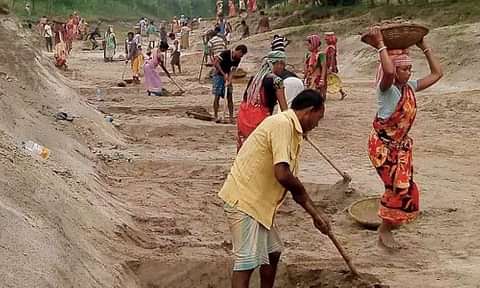SN Misra
Of the various COVID-linked economic packages announced by the government, an additional allocation of Rs 40,000 crore under the MGNREGA programme has attracted special attention. The prime reason for this is that it is likely to create additional 300 crore man-days of work and would absorb a large chunk of work opportunity for the foot loose migrant workers, who are getting back to their states.
A brainchild of the Belgian Economist Jean Dreze, who has adopted India as his own country, this is the biggest employment generator for the most vulnerable sections of the society, the unskilled rural poor. The Programme is demand driven, where 100 days of wage employment is assured o unskilled rural workers. Most of the work involved in MGNREGA is for water related projects like building water bodies, wells, aquifers (more than 50 per cent of fund) and for building roads, temporary houses etc. The programme has a high labour component of 60 per cent cost.
When the NDA government came to power in 2014, the neo-classical economists like Jagdish Bhagwati and Arvind Panagariya called upon the Modi government to trim this programme significantly as they considered it as “inefficient instrument to shift income to the poor”. However, Modi understood that good economics can also be poor economics and has steadfastly persisted with the programme.
The performance audit of C&AG during the 11thPlan “2007-2011” shows low rates of completion compared to targets (30 per cent), poor planning, poor institutional capacity, and high inclusiveness but low durable asset creation. There is legitimate criticism that it has created labour market distortions as workers are not available during harvesting and sowing season, and for construction and manufacturing activities.
On the other hand, the adherents of MGNREGA believe that since most of the skilled workers do not get more than Rs 70-80 per day, most of the time during the year, a way forward is increasing the duration of assured work to 150 days and increasing their wage to `300. This would be a more definitive step to reduce glaring inequity and bolstering demand in the rising economy like India.
Finance Minister Nirmala Sitharaman’s bounty of Rs 41,000 crore is a timely response to the carping critics that this government does not care for the poor. There are some concerns how exactly the leitmotif of MGNREGA is to be freshly inked. The FM has applied the first stroke by increasing the minimum wage from Rs. 173 to Rs. 201. However, there is need to change the definitional scope of workers in the MGNREGA. Dr. MS Swaminathan, the father of green revolution, has said scope of worker should be amplified from unskilled to include the skilled workers. Besides, it must provide coverage to the urban workers. That will help the migrant workers, most of whom are based in urban areas and skilled. An amendment to the MGNREGA through an ordinance will help in this.
Professor Abhijit Banerjee and Esther Duflo have suggested that it is time the government should unleash the UBI scheme and provide Rs. 1,000 per head to every poor person. The dole economics proposed by the Nobel laureates do not make sense. The great depression of 1930s, rendered nearly 26 per cent of people in the US unemployed by 1933. The Cambridge economist John Maynard Keynes in his magnum opus “General Theory of Income and Employment” wrote that the critical anodyne against an economic depression is creation of massive employment opportunity.
The two “New Deal Programs” that Franklin D Roosevelt launched had assured massive employment in projects like the Tennessee Valley Authority. He also unveiled a number of social security measures to ensure right to food, health and shelter to the most vulnerable sections of the society.
According to an assessment made by the World Bank, India should spend about 1.7 per cent of its GDP on MGNREGA, as against the present .5 per cent. However, it must be prudently spent, with the emphasis on creating durable assets. It is being assessed that the fiscal stimulus packages by the government will increase fiscal deficit to 12 per cent and fiscal deficit from 72 per cent to 84 per cent of the GDP of the Centre and states. It will breach the FRBM targets.
But the government must swallow the bitter pill. It is all the more important that higher borrowing is prudently spent for generating employment rather than making cash transfers, which can be inflationary. The country can ill afford stagflation in such depressing times.
The writer is a professor at KIIT University.
